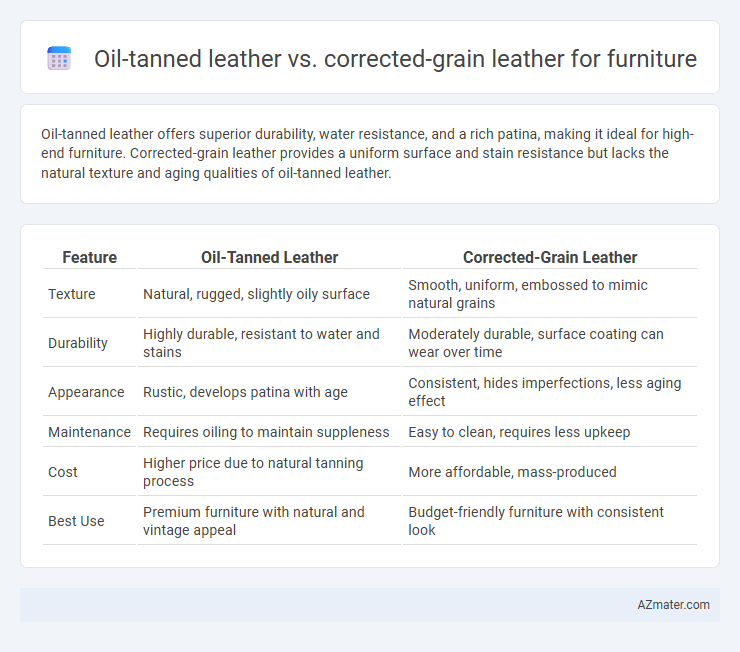Oil-tanned leather offers superior durability, water resistance, and a rich patina, making it ideal for high-end furniture. Corrected-grain leather provides a uniform surface and stain resistance but lacks the natural texture and aging qualities of oil-tanned leather.
Table of Comparison
| Feature | Oil-Tanned Leather | Corrected-Grain Leather |
|---|---|---|
| Texture | Natural, rugged, slightly oily surface | Smooth, uniform, embossed to mimic natural grains |
| Durability | Highly durable, resistant to water and stains | Moderately durable, surface coating can wear over time |
| Appearance | Rustic, develops patina with age | Consistent, hides imperfections, less aging effect |
| Maintenance | Requires oiling to maintain suppleness | Easy to clean, requires less upkeep |
| Cost | Higher price due to natural tanning process | More affordable, mass-produced |
| Best Use | Premium furniture with natural and vintage appeal | Budget-friendly furniture with consistent look |
Understanding Oil-Tanned Leather
Oil-tanned leather, known for its rich texture and waterproof qualities, undergoes a unique tanning process where natural oils are infused, enhancing durability and softness. This type of leather retains the hide's original grain pattern, providing a distinctive, rugged aesthetic ideal for furniture subjected to frequent use and exposure to elements. Oil-tanned leather offers superior resistance to wear and aging compared to corrected-grain leather, which is heavily processed and coated, sacrificing natural character for uniformity and stain resistance.
What Is Corrected-Grain Leather?
Corrected-grain leather is a type of leather used in furniture that has been sanded and buffed to remove imperfections, then coated with a pigmented finish layer to create a uniform appearance. This finishing process enhances durability and resistance to stains and scratches, making it suitable for high-traffic furniture. In contrast, oil-tanned leather maintains its natural surface with minimal alteration, offering a softer feel and developing a rich patina over time but requiring more maintenance to prevent wear.
Appearance and Texture Comparison
Oil-tanned leather exhibits a rich, natural patina with visible grain imperfections that enhance its rugged, authentic appearance, offering a soft and supple texture that improves with age. Corrected-grain leather features a uniform and smooth finish achieved by sanding and embossing, resulting in a consistent appearance with fewer natural markings but a slightly stiffer feel. The choice between the two depends on whether the preference is for a character-filled aesthetic and rich texture or a polished, flawless look with more durability against wear.
Durability and Wear Resistance
Oil-tanned leather offers superior durability and natural wear resistance due to its thick hides and infusion with oils, making it ideal for furniture subjected to heavy use. Corrected-grain leather undergoes surface sanding and coating, which enhances its uniform appearance but can reduce breathability and lead to quicker wear under stress. For long-lasting furniture, oil-tanned leather maintains strength and patina over time, while corrected-grain leather may require more maintenance to preserve its look.
Comfort and Feel for Seating
Oil-tanned leather offers a rich, supple texture that softens over time, providing exceptional comfort and a natural, breathable feel ideal for seating in furniture. Corrected-grain leather features a smooth, uniform surface with a protective coating that enhances durability but can result in a slightly stiffer and less breathable seat experience. Choosing oil-tanned leather enhances seating comfort through its natural flexibility, while corrected-grain leather prioritizes resistance to wear and easier maintenance.
Maintenance and Care Differences
Oil-tanned leather requires regular conditioning with specific leather oils to maintain its supple texture and enhance water resistance, while corrected-grain leather benefits from routine cleaning with mild soaps and occasional application of protective sprays to maintain its uniform finish. Oil-tanned leather's natural surface may develop a patina over time, demanding gentle care to avoid damage from harsh chemicals, whereas corrected-grain leather's artificial topcoat offers more resistance to stains but can peel or crack if improperly treated. Understanding these maintenance differences ensures longevity and aesthetic preservation tailored to each leather type's inherent characteristics.
Stain and Water Resistance
Oil-tanned leather offers superior stain and water resistance due to its dense, wax-infused surface that repels spills and moisture effectively, making it ideal for furniture in high-use areas. Corrected-grain leather undergoes sanding and coating with pigment or finish, providing moderate protection against stains and water but lacking the deep natural barrier found in oil-tanned varieties. For durable furniture that maintains appearance with minimal upkeep, oil-tanned leather consistently outperforms corrected-grain leather in resisting stains and water damage.
Aging and Patina Development
Oil-tanned leather develops a rich, natural patina and softens with age, enhancing furniture aesthetics and comfort over time. Corrected-grain leather, coated with pigments and finishes to hide imperfections, resists stains and scratches but typically lacks the authentic aging process and develops less character. The durability of oil-tanned leather improves with use, whereas corrected-grain leather may appear worn as its artificial surface degrades instead of aging gracefully.
Suitability for High-Traffic Furniture
Oil-tanned leather offers exceptional durability and water resistance, making it ideal for high-traffic furniture due to its ability to develop a rich patina while resisting scratches and stains. Corrected-grain leather, with its sanded surface and applied coatings, provides a consistent appearance but is less breathable and more prone to wear in heavy-use environments. For furniture subjected to frequent use, oil-tanned leather is generally more suitable, delivering longevity and a natural look over time.
Cost and Value Considerations
Oil-tanned leather offers higher durability and a rich, natural finish, making it a premium choice that often comes with a higher upfront cost compared to corrected-grain leather. Corrected-grain leather is more affordable due to surface treatments that mask imperfections but may sacrifice some breathability and aging characteristics. For furniture, oil-tanned leather provides greater long-term value through enhanced wear resistance and patina development, while corrected-grain leather suits budget-conscious buyers seeking consistent appearance with less maintenance.

Infographic: Oil-tanned leather vs Corrected-grain leather for Furniture
 azmater.com
azmater.com